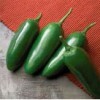Abstract
The jalapeño is derived from the Capsicum genus of the family Solanaceae. Jalapeños are members of a diverse group, which also include ancho poblano, cayenne, serrano, Anaheim, banana, Asian, habanero, and Hungarian wax peppers. Hot peppers are classified by their heat and shape. The heat of the pepper comes from the chemical compound capsaicin, which is measured by the Scoville scale. This 8-page fact sheet is a guide of jalapeño and other hot pepper varieties used in Florida was written by Monica Ozores-Hampton and Gene McAvoy, and published by the UF Department of Horticultural Sciences, October 2014.
References
Burden, D., and D. Huntrods. 2012. Bell and Chili Peppers. AgMRC (Agricultural Marketing Resource Center), Iowa State University. http://www.agmrc.org/commodities__products/vegetables/bell-and-chili-peppers/.
National Garden Bureau. 2007. Horticulture Update. Classifying Chile Peppers. Texas Cooperative Extension, National Garden Bureau. http://aggie-horticulture.tamu.edu/newsletters/hortupdate/hortupdate_archives/2007/Jul07/ClassifChilePeppers.html.
Stephens, J. M. 2012. Pepper, Chili-Capsicum annuum L. and Capsicum frutescens L. Gainesville: University of Florida Institute of Food and Agricultural Sciences. http://edis.ifas.ufl.edu/mv112.
Thornsbury S., A. Jerardo, and H. F. Wells. 2012. Vegetables and Pulses Yearbook Data. US Department of Agriculture. 20 Aug 2013. http://usda01.library.cornell.edu/usda/ers/VEGANDPULSESYEARBOOK/2012/89011.pdf.
US Department of Agriculture. 2012. Statistics of Vegetables and Melons. 20 Aug 2013. http://www.nass.usda.gov/Publications/Ag_Statistics/2012/chapter04.pdf.
Wright, S. 2013. Heirloom Vegetables. Cooperative Extension Service. Univ. KY, College Agri. http://www.uky.edu/Ag/NewCrops/introsheets/heirloom.pdf.

